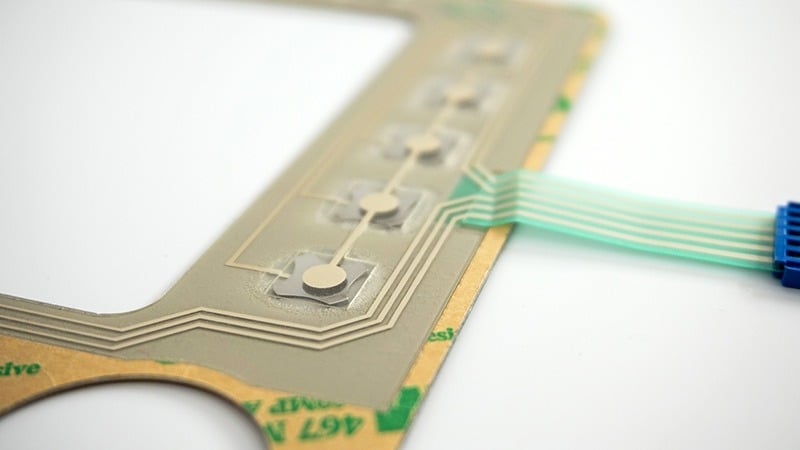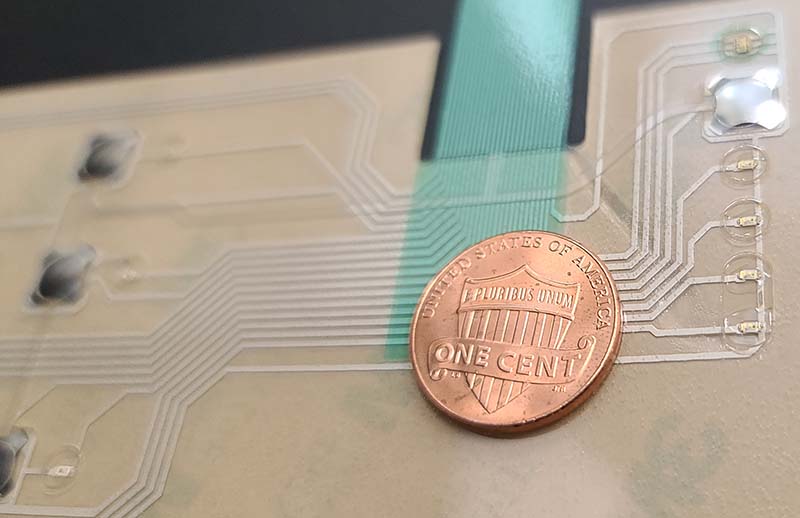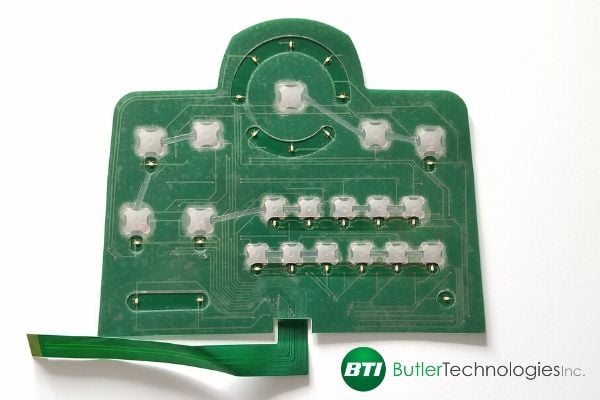What is flexible fine line circuitry?
A flex circuit combines a thin, flexible substrate, fine line conductive traces, surface mount devices (SMD), and some termination or connector. Fine line circuitry is one example of various electrical component designs categorized under Flexible Hybrid Electronics (FHE).
FHE is a product solution that combines the functionality of rigid PCBs with the form factor of precision screen printed flexible circuits on polymer thick film (PTF). Usually, the product is very flexible with only a few hardware parts like LEDs, memory, and processors.
What is fine line flexible circuitry used for?

Fine line circuitry is used for a variety of products. Some of the most common applications are smart identification tags, printed antennas, force-sensing resistors, capacitive touch sensors, wearable devices, circuitry for membrane switch, and other electronic hybrid assemblies.
One of the most common circuits that get design and printed at BTI is used in membrane switches. A membrane switch often includes a couple of layers of circuitry and dielectric ink to insulate the circuitry where needed. The circuity in a membrane switch can also include hardware components like LED’s, metal domes, and connectors that get assembled to the rest of the circuitry after it is printed.
Through Flexible Hybrid Electronic solutions, manufacturers can create control circuits or active sensors that are lightweight, low-cost, faster to market. They conform to the curves of a human body or product structure. Many FHE solutions are incorporated into wearable, sensor, or instrumentation applications for the digital Healthcare, Apparel, Automotive, Aerospace, and Industrial IoT markets.
How is a flex circuit designed?
Once the design parameters for the project are talked through, electrical engineers at BTI begin to design the flexible circuits. They consider things like how much electrical current is going to be needed to run the device. Electrical engineers use the design parameters to create the circuit as fine lines or as wide as required. Typically flex circuits used in membrane switches are pretty wide. On the other hand, fine line circuits are designed for products like printed sensors and antennas.

BTI can produce FHE circuits that are 1 or 2-sided with multiple layers per side achieved by incorporating thru-hole and blind vias. Once the circuit is fabricated, a highly functional device can be created by placing surface mount components and connectors.
Common materials used in flexible circuit design are heat stabilized polyester or PET, synthetic paper, polyimide, and thermoplastic polyurethane or TPU. Inks are selected based on conductive requirements. Usually, the inks in a flexible circuit are silver, carbon, copper, PEDOT, and dielectric or insulating. Some products also require a carbon overprint for added durability and to prevent any silver ink from moving. Also, depending on the design, there are specialty inks like PTC or FSR carbon ink.
BTI can print very fine line traces and spaces, allowing for high-density, flexible circuitry. The smallest traces can be as fine as 50 microns, which is smaller than the text on a penny!
How is a flex circuit manufactured and assembled?
Flex circuits made at Butler Technologies go through a variety of printing, finishing, and assembly processes. To stick with the same example, membrane switches go through the engineering and graphics departments first. A membrane switch often includes many layers, not just circuitry. The top layer of a membrane switch is a graphic overlay. The graphic overlay could be screen or digitally printed. It is common for the graphic overlay layer of the membrane switch to be digitally printed while the electrical components are screen printed.
The graphics department also works with the screen printing department to create the necessary films for printing. Once the films are complete, the design starts to get printed layer by layer. Precision printing presses have 4 posts to create consistent and precise fine line circuits. Some graphic overlays will still need to be printed using a screen printing press. Specialty inks like metallics and medical-grade coatings are not compatible with a digital printing press. Our digital printers are used for any graphic overlays that have gradients and complex color designs.
Once the circuitry and any other layers of the product get printed, they go to the finishing department. It is common for multiple switches to be printed on one sheet. Once the design gets to the finishing department, they get laminated if needed and cut out using a die tool, plotter cutter, or laser cutter.
Once the components are finished, the assembly team begins to add the other features. They can add things like metal domes, LEDs, and connectors.
What is the difference between a PCB and Flexible Circuits?

PCB is a relatively common term for anyone involved in the electronics world. Typically, PCB stands for the printed circuit board. Since the word board is in the definition, it implies that the circuit is stiff and rigid. PCBs can’t flex, or else they will break. This is a big concern for many designers.
Flexible circuitry is still new to many people involved in the electrical component design world. Flexible circuitry is an excellent solution for product engineers and designers looking for components that need to move or bend.
In many instances, flexible circuits offer advantages over traditional rigid circuit boards, including a thin, flexible & stretchable form factor, lower cost, additive process, reduced lead-time, and several material options.
Conclusion
BTI
can assist you with the design, prototype development, and production ramp-up of a highly functional, robust solution, whether the end use of your FHE application.
Meet the Author

Ashley Foster is a graduate of Slippery Rock University, where she earned her Bachelor’s degree in Business Administration, majored in Business Management, and minored in Marketing. While Ashley was studying at SRU, she found a passion for marketing. She loves to spend her free time traveling and hiking with friends. Ashley is also the Vice President of Programming for the American Marketing Association, Pittsburgh Chapter, and an active alumni member of FCCLA.